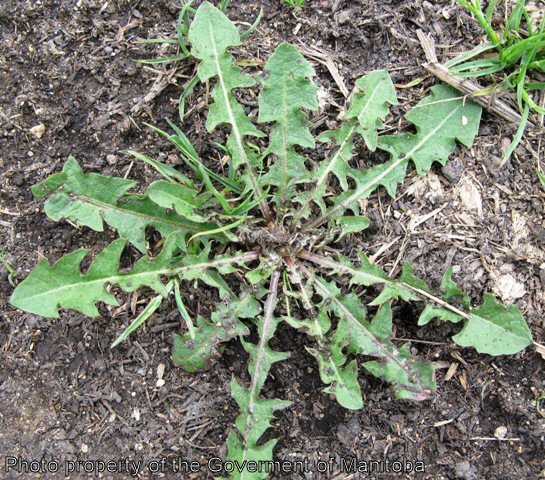Controlling Dandelion In The Fall
There are a couple of things that a producer needs to understand about the dandelion plant in order to effectively control this weed.

This weed is a simple perennial. This means that it will persist from year to year because of an over-wintering tap root, but it only spreads by seed. Dandelion produces about 2500 seeds per plant per year. This is a fair amount of seed and it is very mobile. The one factor that is positive about the seed is that it has little dormancy. This means that the seed germinates the same year it is produced, and if you control the resulting seedlings (as well as the perennial plants), you will have done a good job on the whole population in your field.
The other variable that producers need to understand is how the plant grows. The seed does not germinate in the spring like many weeds. It begins germinating during the summer beginning in late June to early July. This is important, because farmers usually spray their fields in early June and miss the late arriving dandelion seedlings.
Farmers have a number of herbicide application timing options when it comes to spraying any field. Pre-seed applications of glyphosate alone or with a top-ups such as 2,4-D, Express or florasulam (Pre-pass) are common and effective options for this period. The problem with this time of application is that very often the over-wintering perennial plants from last year have already flowered and set seed. This year dandelions were flowering in mid to late April in my yard. So when producers are spraying a pre-seed application they are controlling the perennials only. 3-4 weeks later the seeds that were produced earlier in the spring will germinate and you have to start all over again.
As mentioned above, in-crop applications of herbicides are too early to control the un-germinated seeds. Therefore the same scenario unfolds as the pre-seed applications. A farmer spraying dandelions in-crop may control the perennial plants but misses the seedling that have yet to appear for that year.
Pre-harvest applications have a different problem. The timing makes sense. In August when pre-harvest glyphosate applications go down, both the perennial plants and most of the seedling are present. The problem with this scenario is getting adequate coverage of the dandelion plants. This weed is a low growing plant that hugs the ground. Pre-harvest applications have to penetrate the crop canopy to get down to the dandelions, and this very often is an impossible task.
This leaves the last application timing available to a farmer; post-harvest. Spraying after harvesting operations are completed is the best time for dandelion control. Both the perennial plants and the seedling are present and easily accessible to herbicide applications. Producers should use at least 1.5 L of glyphosate / acre (360 g ai/L formulation). Other options include top-ups with the glyphosate such as 2,4-D or Express, or the use of a non-glyphosate approach such as Amitrol. Anyone spraying for dandelion needs to read their herbicide label(s) thoroughly to ensure proper rates of application as well as using only registered tank-mixes and to ensure that there are no residue concerns for the following crop.
Herbicides are not the only control option. Tillage is also an effective means of controlling this weed. In fact we are probably seeing more dandelions in the Province because of the move to conservation tillage systems. Timing of tillage is the same as that for herbicide applications. Post harvest tillage is the best.
When controlling dandelion in the fall, producers need to ensure that the plants are actively growing. Hard frosts and droughts will effectively stop the weed from actively growing and therefore impair control efforts. The weeds needs to healthy and able to take up the herbicide in order to get it to the roots. Dandelion is a perennial plant and any control operation needs to ensure that the root is destroyed. Simply burning off the leaves will not result in full control. So now is the time for producers to be out scouting fields for this weed. The later we delay, the greater the risk of a killing frost resulting in poor control of and a waste of a farmer’s time and resources.

